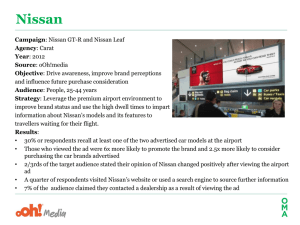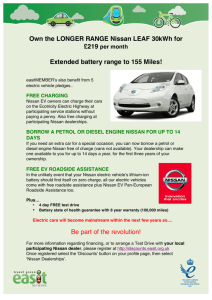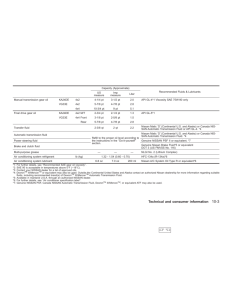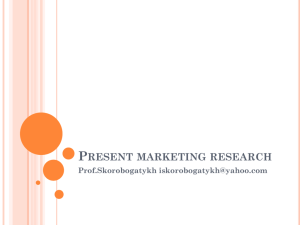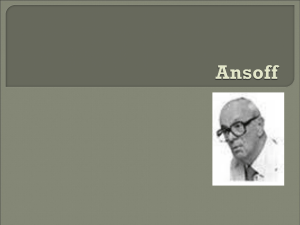File
advertisement
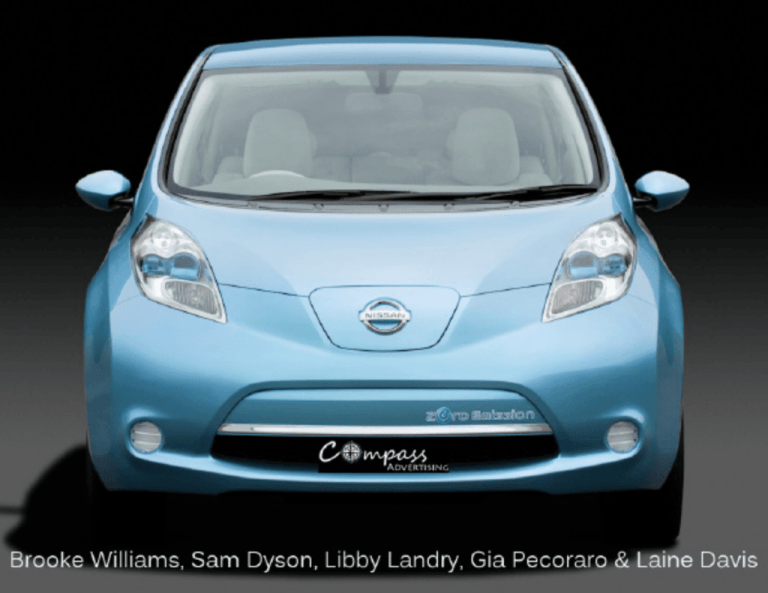
Contents Executive Summary Marketing Problem Industry Analysis Brand Analysis Advertising Usage Corporate Info Competitors Analysis Nissan Swot Analysis Competitors Swot Analysis Marketing Objective Target Profile Media Objective Overall Target Coverage Media Objective Media Budget Regionality. Seasonality, Scheduling Media Strategy & Tactics Media Flowchart Concept Testing Creative Strategy Promotion/IMC Efforts Copy Testing/Evaluation Appendices 3 4 5 6-7 8-9 10 11-12 13 14 15 16-18 19 20 21 22-24 25-26 27 28 29-32 33-36 37 38-39 Executive Summary Marketing Problem Marketing Objective Regionality, Seasonality, and Scheduling Nissan currently ranks third in multicultural (MC) Increase market share among multiculturals from 13 We will use a pulsing schedule with high reach and frequency in November-January and May-July. Our market share, behind Toyota and Honda, respectively. to 17 percent in fiscal year 2013. campaign will target consumers in the West and the Industry Analysis Target Profile South. An average of 11.5 million vehicles are sold each year. This campaign targets consumers of Hispanic, AfriMedia Mix can American, and Chinese descent, ages 18-29. Our Brand Analysis secondary target includes all others within that eth- The following media mix is proposed: 58 percent allocated for television, 20 percent for magazine, 15 nic demographic over the age of 30. Nissan ranks third in MC market share and fifth overpercent for digital and five for both newspaper and all. Media Objective outdoor advertising. Corporate Info Through media usage, we hope to increase awareCreative Strategy ness of the brand and it’s new image by 40 percent Nissan sponsors the Heisman Trophy, funds the NisThese three sample advertisements aim to reach in fiscal year 2013. san Green Program, and diversity programs such as the target audience effectively and convince them to NNA. Overall Target Coverage take a drive with Nissan. Competitors (Primary) Nissan’s primary competitors are Toyota and Honda. Competitors (Secondary) Nissan’s secondary competitors are Ford, Chevrolet, and Hyundai. Compass aims to have an average frequency of 5 advertisements with an average reach of 50 percent. Media Budget We will allocate $85 million for media usage. 3 Promotion/IMC Efforts Compass proposes extensive promotion of the Heisman sponsorship, continuing to update social media outlets such as Twitter and Facebook, and sponsoring cultural festivals such as Essence Fest and Chinese Heritage Festival. Marketing Problem Nissan currently ranks third in multicultural market share with 13 percent, which is behind Toyota and Honda, respectively. Nissan’s current campaign does not effectively reach the target audience. Their consumer is unresponsive to the current advertising and marketing campaigns. 4 Industry Analysis Since 2008, an average of 11.5 million cars are sold a year, which is lower than the average of 16.8 million cars from 2000-2007. There are around 250 million vehicles in use in the United States and more than 806 million vehicles in use around the world. This consumes over 260 billion gallons of gas each year. In 2010, global production of automobiles was 26 percent, up 38 percent from 2009. The United States ranks seventh in motor vehicle production with over seven million vehicles produced each year. China and Japan rank first and second, respectively. The automotive industry in the United States is a 300 billion dollar industry. 5 Brand Analysis By the numbers: 3 - place, multicultural (mc) market share 13 - percent, mc market share 5 - place, overall market share 9.6 - percent, overall market share 22 - models of Nissan vehicles 100 - dollar amount in billions of revenue 200,000 - Nissan employees 6 Brand Analysis History: Nissan first came to the United States to sell vehicles in 1958 and began importing and making Datsun vehicles in the United States under the Nissan Motor Corporation, U.S.A. (NMC), name in 1960. In 1990, Nissan North America Inc. (NNA), was created to coordinate all of Nissan’s various activities in North America to enhance the design, development, manufacturing and marketing of Nissan vehicles. In 1998, the two organizations merged operations under the name Nissan North America, Inc. NNA’s mission is to provide all Nissan and Infiniti employees and dealers with the tools they need for constant improvement and consumer satisfaction. Nissan says that a “SHIFT_” has been made. In the past decade, it has doubled the number of models offered as well as doubling its sales. Distribution: Nissan products are distributed and sold all over the United States as well as internationally. It markets eleven vehicle lines through 1,100 dealers in the continental U.S. through fleet sales , which are high volume sales designated to come from large companies and agencies and are sold at a discounted price. Nissan has three production plants in the United States: Smyrna and Decherd, Tennessee, and Canton, Mississippi. Production at Nissan’s Smyrna Plant began in June 1983. The vehicle assembly plant has an annual production capacity of 550,000 vehicles and represents a capital investment of $2.5 billion. Cost: Nissan Versa Sedan: $10,990 Nissan GT-R: $89,950 7 Advertising “Making cars that are more efficient, more beautiful, more inspiring, and more human than ever before. It means, simply, making cars that change the world and the way we move through it.” 8 Advertising Usage Figure 1 Figure 1 displays Nissan’s current Media Mix. We plan to change this mix to better execute our media and marketing objective. 9 Corporate Info Nissan has programs such as the Nissan Foundation which supports educational programs that celebrate and foster appreciation and understanding of our diverse cultural heritage. They are committed to diversity and have programs such as NNA Mentoring Program to support this cause. Nissan also runs the Nissan Green Program which seeks a symbiosis of people, vehicles and nature. Nissan sponsors the Heisman and NCAA Football. The Heisman includes anything involving the Heisman watch, updates and any other information broadcast about the Heisman. Nissan has many tie-ins with NCAA Football programming. They also sponsor a fitness program named “Innovation for Endurance,” which supports healthy living and fitness particularly cycling and running. These activities are relevant to the overall Nissan brand target. This sponsorship is a partnership with Rodale Publications that involves surrounding the Nissan brand with Rodale content. 10 Competitors(primary) Toyota leads the multicultural industry with 22 percent of the market share and leads the overall auto industry with 16 percent. Toyota USA began in 1957 and has accomplishments such as making the world’s first mass-produced gas/electric hybrid car. Toyota has long used it’s slogan “Toyota. Moving Forward.” 11 According to the case book, Honda ranks second in multicultural market share with 16.6 percent. Honda has the fourth largest overall market share at 14 percent. They began in the US in 1959. Honda uses it’s slogan “The Power of Dreams” in its advertising campaigns. Honda sponsorships include the New Orleans Jazz and Heritage Festival, Anaheim Ducks, Collegiate Women Sports Programs and the Los Angeles Philharmonic. Competitors (secondary) Ford Motor Company is an American automaker currently ranking second in market share with 14.2 percent. Ford is the largest family-controlled company and has been in operation for more than 100 years. They have 3 cars with over 40 mpg. Some sponsorships include Box Tops for Education, Little Caesar’s Pizza Bowl, NASCAR and the Susan G. Komen Race for the Cure. Advertising slogan “Built Ford Tough.” Chevy is produced by General Motors (GM), founded in Detroit in 1911. Currently celebrating their 100th year with successful ad slogans such as, “Like a Rock,” and “An American Revolution.” Their current campaign is “Chevy Runs Deep.” They were the first to use the anti-lock braking system. Chevrolet sponsors many companies and events such as The X Factor, the movie Transformers, the CMA’s and “Sing the USA.” 12 Hyundai began selling its vehicles in the United States in 1986. After many negative reviews claiming bad quality, Hyundai invested heavily in the quality, design, manufacturing, and long-term research of its vehicles. Hyundai has released a new slogan titled, “New Thinking. New Possibilities.” Their biggest sponsorship includes the 2006 FIFA World Cup. Hyundai has made the largest gains in market share during the past few years coming from relative unknown to industry mainstay. Nissan SWOT Analysis Strength Weakness Opportunity Threat Solid MC market share Dependence on overseas market NISSAN Leaf electric vehicle Inconsistent ad campaign Diverse line of vehicles Dependence on top selling vehicles Wide consumer base Introduced line of full-size commercial panel van Lose consumers if not targeted properly Gets lost in the clutter Room to grow 13 Competitor SWOT Analysis Strength Weakness Opportunity First in overall market share Safety issues with brakes Top manufacturing company Low truck sales Saw strong sales of Yaris, Corolla, and Scion xB Affordable Good safety ratings Good fuel efficiency Improved its North American production plan Many products other than standard vehicles Low truck sales Consumers: bad fuel American automaker Investments on fuel efficient efficiency vehicles Threat Competition from Honda and Nissan Slow to restock the US after the March earthquake Slow to restock the US after the March earthquake First mass-produced gas/elec- America in a recession tric hybrid vehicle Growing interest in ecofriendly vehicles Large parent company International distribution Recognizable brand logo Struggling Lincoln-Mercury brand Government owns a 27% stake in GM Developed more fuel efficient cars Promise to produce better vehicles America in a recession Threat of substitutes Fourth in motor vehicle manufacturing Reputation for poor quality Expansion in the US Good ratings from Consumer Reports Brand reputation 14 Marketing objective Increase market share among multicultural consumers by four (4) percent, from 13 to 17 percent, in the fiscal year 2013. We have a chance to grow This will us ahead of Honda and right behind Toyota. The multicultural market is currently strong for Nissan, so we want to continue to establish and program loyalty in this market. 15 Target Profile For this campaign, we are targeting consumers of Hispanic, African American or Chinese descent ages 18-29. Our secondary target is everyone else within those ethnic demographics ages 30 and up. Nissan’s multicultural share among these groups is not growing at a pace comparable to competitors such as Toyota and Honda. Therefore, the goal of our campaign is to increase the multicultural share for Nissan. 16 Shared Insights: -being true to yourself -acknowledging their cultural history -eco-friendly -pursue their endeavors with passion -like to see both style and substance represented from brands of good reputations -Internet and mobile are great ways to reach them -use social media in seeking out brands Target Profile The targets tended to like foreign car brands more than U.S. car brands. The strongest brand preference in our survey results was Toyota followed by Honda and Nissan, which were tied for second. When examing brand likability and likelihood to purchase a vehicle from the brand, Toyota lead with 50 percent of respondents selecting Toyota for both. Nissan was just under 50 percent for very likely in both brand likability and likelihood to purchase. Ford did poorly receiving mostly negative responses across all answers. The media usage questions on our survey highlighted that this group primarily uses television, Internet and social media. With at least 33 percent of all respondents marking these results as very likely to use, and 50 percent responding likely to use. Most important to this campaign is how this group of multicultural millenials views cars. They want thrilling cars that are ecofriendly with the newest technology. They want a fun vehicle with innovative designs that can be personalized to their own tastes. Our survey supported these ideas by showing a strong support for fuel efficient features in cars as well as luxury and style aspects. Sixty-two percent said luxury is most important and 91 percent claimed that fuel efficiency is most important. 17 Target Profile Javier 24 year-old Hispanic Masters from UCLA $68,000/year Watches TV Buys himself a Nissan Altima for graduation Melissa 25 year-old African American Graduate from UGA $50,000/year Magazine subscriber She buys herself a Nissan Maxima to commute to work 18 Erik 29 year-old Chinese Pursuing doctorate from Berkeley $78,000/year Relies on technology He buys a Nissan Rogue for his wife as a family vehicle Media objective Nissan needs to create brand preference to pass Honda and Toyota in the multicultural market. Nissan also should try to keep and encourage brand loyalty among this market as well as the whole market to continue to gain share in the market. We will change the current Nissan campaign to one that will motivate the target audience. Based on concept testing, we plan keep “SHIFT_the way you move” but change “Innovation for All.” Through media usage, we hope to increase awareness of the brand and it’s new image by 40 percent in fiscal year 2013. Figure 2 below shows each brand’s current market share in the multicultural market. Following our campaign, Figure 3 demonstrates what we expect the market share of the mulicultural market to be. Current Mutlicultural Market Share Expected Multicultural Market Share Figure 2 Figure 3 19 Overall Target Coverage 12,880,000 Increase Nissan’s market share by four percent. To do this, we will need to take on an offensive strategy. This figure represents the total multicultural millennials in the US. Reach and frequency will be fairly even but with slightly more focus on frequency. 6,440,000 We plan to have an average reach of about 50 percent and an average frequency of 5. This figure represents the expected number of multicultural millennials the campaign will reach per month. This means we will be trying to cover an average of about 6 million multicultural millennials with 5 ad exposures each month all year round. However the reach and frequency will be at 70 percent and 7 respectively during peak months. This should allow Nissan to to build a strong and favorable brand identity among multicultural miliennials. 20 Media Budget We are going to keep the budget at 100 million dollars, but we will use less than 100 million on media because some of the budget must also go towards PR and IMC efforts. Budget Allocation Figure 4 Outdoor $4,250,000 We expect to use 85 million for the advertising budget. For television we will allocate 55 percent of our advertising budget, which is about 46 million dollars. We will spend 15 percent on digital media consuming about 12 million dollars of our budget. Twenty percent of the budget is going to be spent on magazines costing 17 million dollars. Newspaper and outdoor advertising will both take up 5 percent each consuming about 4 million dollars of the budget. Newspaper $4,250,000 Magazine $17,000,000 Digital $12,750,000 Television $46,750,000 The exact amount we will allocate to each media is shown in Figure 4 above. They each represent the percent of the $85 million budget they comprise. 21 Media Objective Regionality We want to focus our campaign in the South and the West. The West had exceptionally strong indices in both the Asian (199) and Hispanic (181) demographics. The West did poorly for African Americans (43), but it was strong enough in the other two groups that we will still include it. The South was the best region for African Americans (151), respectable for Hispanics (98), but poor for Asians (56). The Northeast was strong for Asians (134) and close to average for the other groups: Hispanic (78) and African American (94). This makes the Northeast a safe place to go if we want added coverage. Since we plan to use an offensive strategy, the South and West are our best bets while we should stay away from the Midwest. These regions also represent the best mix of strong markets for Nissan, since no single region was strong for all demographics. Figure 5 Figure 5 represents the amount of cars bought in each region of the United States. The dark red represents where the most cars are bought. This figure confirms that targeting the west and the south will be the most effective. 22 Media Objective Seasonality Automobiles are a year round product and our seasonality plan should reflect that. There are times that car sales may be expected to spike like during the holidays, graduation, and summer. There is also a large potential to connect the strong cultural values of the family aspect during the holidays. Because of this seasonality we will have 6 months, November though January and May through July, where we increase our reach and frequency. This will help drive sales in these crucial months. 23 Media Objective Scheduling Based on the apparent seasonality for the product, we will use a pulsing schedule. While, Nissan needs to sell vehicles year round, they should realize that a large portion of their sales will come during the peak months. This is the reason we have selected to pulse and advertise more during these months to help stimulate sales. Since, we will still be selling vehicles during the rest of the year we need to advertise during these times as well. Figure 6 8 7 6 Figure 6 is a graph of the pusling schedule we plan to use. It confirms that we will increase our reach and frequency in our peak months, but we will still advertise in months other than our peak months just not as heavily. 5 4 3 2 1 0 Jan Feb Mar Apr May Jun 24 Jul Aug Sep Oct Nov Dec Media Strategy & Tactics Media (Classes/Vehicles) Rationales Based on the data from Choices 3 and the case, TV is a powerful and needed medium for our campaign. There are multiple network and cable stations that did well with large indices. The case shows that TV of some kind dominates each group’s media mix with averages of 40 percent per mix. Some channels our target audiences watch frequently include the Food Network, MTV and MTV2, Discovery, Animal Planet and ESPN. Other media to consider include print and digital, but more emphasis on TV and digital than print. We will also focus more on magazines and less on newspaper. Magazines we plan to use include Discover, Entrepreneur, Forbes, Fortune, Nation Geographic Adventure and Sport Illustrated. Print is usually used to reach harder parts of your target or to get very specific, which isn’t much of a concern here. Digital media tested well in the case analysis and fits some of the “early adaptor” image of the multicultural millennial. They react well to Internet ads and are heavy Internet users. Based on the case study, they are very likely to use the Internet for relaxation, inspiration and information 25 Media Strategy & Tactics Our Media Mix graph, which is shown here in Figure 7, demonstrates the percent of the budget each media will take. Television comprises the majority of the budget with 55% since it is the largest media amoung our target audience. Media Mix Budget: $85 million Figure 7 Digital 15% Magazine 20% Newspaper 5% Outdoor 5% Television 55% 26 Media Flowchart Figure 8 TV $ Spending GRP's Magazine $ Spending GRP's Digital $ Spending GRP's Outdoor $ Spending GRP's Newspaper $ Spending GRP's Jan Feb Mar Apr May Jun Jul Aug Sep Oct Nov Dec Total '000 4,545,138.89 2,921,875.00 2,921,875.00 3,895,833.33 4,545,138.89 4,545,138.89 4,545,138.89 3,895,833.33 2,921,875.00 3,895,833.33 4,545,138.89 4,545,138.89 46,750.00 490 90 90 250 490 490 490 90 90 250 490 490 3,800.00 1,239,583.33 796,875.00 796,875.00 1,062,500.00 1,239,583.33 1,239,583.33 1,239,583.33 796,875.00 796,875.00 1,062,500.00 1,239,583.33 1,239,583.33 12,750.00 490 90 90 250 490 490 490 90 90 250 490 490 3,800.00 1,652,777.78 1,062,500.00 1,062,500.00 1,416,666.67 1,652,777.78 1,652,777.78 1,652,777.78 1,062,500.00 1,062,500.00 1,416,666.67 1,652,777.78 1,652,777.78 17,000.00 490 90 90 250 490 490 490 90 90 250 490 490 3,800.00 413,194.44 265,625.00 265,625.00 354,166.68 413,194.44 413,194.44 413,194.44 265,625.00 265,625.00 354,166.68 413,194.44 413,194.44 4,250.00 490 90 90 250 490 490 490 90 90 250 490 490 3,800.00 413,194.44 265,625.00 265,625.00 354,166.68 413,194.44 413,194.44 413,194.44 265,625.00 265,625.00 354,166.68 413,194.44 413,194.44 4,250.00 490 90 90 250 490 490 490 90 90 250 490 490 3,800.00 Figure 8 includes the GRP’s and amount of budget spent each media. The GRP’s and budgets are highest in our six peak months. 27 Total Spent 85,000.00 Total GRP's 19,000.00 Concept Testing Details: Outcomes: -Surveyed & interviewed 20 participants -Tested current Nissan copy -Tested potential copy based on previous research -Contained twelve Likert scale questions & open ended questions concerning attitudes toward design for car ads Top 3 copy: -Go ahead... try me average rating: 3.7* -It’s your life, be in the driver’s seat average rating: 3.6* -It’s not the destination, it’s the journey average rating: 3.6* *Based on likert scale 1-5 28 Creative Strategy The main theme of the new campaign is keeping Nissan’s current tagline, “SHIFT_the way you move,” but altering it to fit the attitudes of the target audience. The current tagline received an average rating of 3.5 on the Likert scale during our concept testing, so we decided to keep it in Nissan advertisements. We will also supplement it with another tagline that corresponds with the theme of each individual advertisement. Our concept testing also showed that the target audience enjoys mostly graphics with some copy. Furthermore, they like advertisements that show benefits or features of the car. Therefore, the print advertisements will be mostly graphics with a couple benefits and television commercials will focus more on the special features each car possesses. 29 Creative Strategy Creative Brief “Go ahead... try me” Objective- increase awareness of the new Nissan LEAF Target audience- multicultural millennials ages 18-29 Needs/wants- eco-friendly and luxury cars they can afford What we have to offer- the eco-friendly Nissan LEAF Message communication- the print ad includes a bold green leaf to further enhance its eco-friendly traits, the tagline appeals to the curious nature of the target audience and invite them to test drive, and hopefully buy, the Nissan LEAF Seasonality/Scheduling- summer months before and after graduation, back to school season 30 Creative Strategy Creative Brief “It’s your life, be in the driver’s seat” Objective- instill a sense of control the mind of our target audience Target audience- multicultural millennials ages 18-29 Needs/wants- find their place in life, live passionately What we have to offer- endless possibilites of where life can go Message communication- does not focus on one particular car so it shows that Nissan has a car that can fit any individual lifestyle Seasonality/Scheduling- year-round advertising 31 Creative Strategy Creative Brief “It’s not the destination. It’s the journey.” Objective- showcase the variety of features of Nissan cars Target audience- multicultural millenials ages 18-29 Needs/wants- value style and substance, base purchase decisions on functionality, quality and reliability What we have to offer- appeal to their need for adventure Message communication- slogan shows the importance of the journey and how Nissan can make that journey more comfortable and safer with the variety of features Nissan offers Seasonality/Scheduling- year-round advertisements 32 Promotion/IMC Our IMC and promotional efforts will play an integral part in relating to our multicultural target audience. We will allocate $15 million dollars of our budget toward this aspect of our campaign. We will utilize social media by means of Facebook. Our target enjoys and frequents this social media site. This owned media will essentially cost us nothing, but it will allow us to disseminate a controlled message to our audience. Through Facebook we will continue the “Innovate the Heisman Pose” promotion. Users will submit their version of the Heisman pose to win tickets to a championship bowl game. This will continue to maintain and strengthen the sponsorship with the Heisman. 33 Promotion/IMC Heisman Sponsoship Our sponsorship of the Heisman keeps us at the forfront of our target’s mind and it will generate earned media by word-of-mouth. We plan to have a partnership with Coca-Cola and their brand Powerade. It will involve setting up in-store displays during football season. To spark further interest in the in-store displays, the caps of the Powerade bottles will be used to acquire points toward winning a ticket to the Heisman ceremony. This will also build recognition for Nissan since the displays will be from Nissan. 34 There is a seemingly large cost incolved with a Coca-Cola partnership, but seeing as this equally promotes Powerade and our other IMC and promotional initiatives are low-cost, budget allocation for this should not be a problem. We plan to make this as cost effective as possible by not re-packaging the Powerade bottle. Money saved from not repackaging will be used toward football and Heisman themed events and commericals highlighting successful Heisman recipients of the past such as Ernie Davis, the first African American recipient, and Jim Plunkett, the first Latino recipent. Promotion/IMC Sponsor large-scale ethnic festivals -Chinese Heritage Festival put on annually by the Chinese American Student Association of the University of Southern California -Held in the west, which has high index of Chinese-Americans -Essence Music Festival in New Orleans, Louisiana -Held in the south, which has high index of African Americans -We want to use cultural festivals to focus on the small multicultural markets The Chinese American Student Association charges a 50 dollar lifetime membership fee, so although we do not know how much it will be to fund this festival, we are fairly certain that we will have enough budget to sponsor some events. 35 Promotion/IMC Nissan Green Program Nissan de Mayo “Nissan de Mayo” is a combination of a trade promotion and a sales promotion in the month of May. Durinng the month of May, the sales promotion will go on providing discounts and promotions for the consumer. Also, trade promotion will be involved because dealers will have incentives for sales volumes such as bonuses, inventory additions, etc. The primary objective is to reduce carbon dioxide (CO2) emissions from production, manufacturing May is a great month for promotions due to graduations and is a high advertising month for this campaign. and other carbon dioxide emitting activities. This coincides with the introduction of the Nissan Leaf, which fulfills these initiatives by reducing fuel consumption. This will generate the cost efficient earned media that is crucial in building a trusted brand of choice. 36 Copy Test/Evaluation Once the campaign is carried out, its effectiveness will be measured using concurrent, posttesting and diagnostic research. This will involve attitude tests to see if the advertisements are portraying the correct tone and tracking studies to see if there has been an increase in sales among the target demographic. The act of testing, monitoring and measuring both during and after the campaign is crucial to determine the cognitive, affective and behavioral attitudes of the target demographic. Test markets would include, but not limited to, Atlanta, Houston, Los Angeles and San Diego. The tests will be conducted mid-way through the campaign to make any small but necessary changes and again at the end to see if Nissan would like to extend the campaign if it brought them the success they wanted. 37 Appendices/References Figure 1 This represents the current media mix used by Nissan. They currently allocate the most money to television and magazines. References USC Chinese American Student Association. (2011). USC CASA. Retrieved from http://www.usccasa.com/ Figure 2 This represents the current rankings of each brand in the multicultural market share. Nissan ranks third following Toyota and Honda, respectively. Nissan Global. (n.d.). Nissan Green Program. Retrieved from http://www.nissan-global.com/EN/ENVIRONMENT/GREENPROGRAM_2010/ Figure 3 This represents the expected ranking of each brand once the campaign in implemented. Nissan is expected to increase its market share by 4 percent to rise above Honda in the multicultural market share. Nissan USA. (n.d.). Retrieved from http://www.nissanusa.com/ Figure 4 This represents the dollar amount Nissan will allocate to each medium with the new campaign. The majority will be spent in television and magazines. CIA World Factbook. (2011, 11 18). Retrieved from https://www.cia.gov/library/publications/the-world-factbook/ Figure 5 This represents the amount of car sales in the United States. The dark red is where the most sales occur and the light red is the least amount of sales. Ad $ summary multi-media service, January-December 2008. (2008). New York, NY: Magazine Publishers of America, Inc. Figure 6 This represents the pulsing schedule this campaign will use. The most advertising will occur in November through Jan and May through July. Simmons Market Research Bureau. (2011). Simmons OneView (2011) [Computer software]. New York: Simmons Market Research Bureau. Figure 7 This represents the media mix recommended for Nissan. These media were chosen based on Choices3 data and Nissan’s current media mix. The majority of the $85 million budget will be allocated to television and magazines. Figure 8 This is the flowchart for the overall campaign. It outlines the media usage, reach and frequency goals and average GRPs for each month and for the overall campaign. National Student Advertising Competition (2011) [Case Book]. Nissan Case Study. Vermont: Education Services, American Advertising Federation 38 Appendices/References Survey Questions Age Gender 1. Please rate how you feel about the following companies: Strongly agree – strongly disagree 6. Please rate your likelihood of buying vehicles made by the following brands – very likely to very unlikely Nissan, Honda, Toyota, Ford, Chevrolet, Hyundai Nissan, Honda, Toyota, Ford, Chevrolet, Hyundai 2. Please rate your experience with the following brands: Very good – very bad 7. What factors are important to you in a vehicle (check all that apply) – fuel efficiency, luxury, cost, reliability, warranties, safety, eco-friendly Nissan, Honda, Toyota, Ford, Chevrolet, Hyundai 8. What do you think of when you think of Nissan? 3. Which of the following brands do you associate the most with? 9. What brand of car do you drive? Nissan, Honda, Toyota, Ford, Chevrolet, Hyundai 10. What do you focus on the most when you purchase a car? (Check all that apply) – style, cost, fuel efficiency, eco-friendly, dealership environment 4. Please rate how much you agree or disagree with this statement for each brand: This brand produces a good quality vehicle – strongly agree to strongly disagree Nissan, Honda, Toyota, Ford, Chevrolet, Hyundai 5. Based on the Nissan brand, please rate how much you agree or disagree with the following statements – strongly agree to strongly disagree Nissan vehicles are safe. Nissan vehicles are luxurious. Nissan vehicles are good vehicles. Nissan vehicles make me feel ___ Nissan vehicles are flashy. 11. What medium is the best way of reaching you? Please check one. TV, radio, social media, billboard, etc 12. Which forms of digital media do you use? Facebook, Yahoo, Twitter, 13. Rate your feelings toward brand sponsorships. Then, Do you know what/who Nissan sponsors? 39
